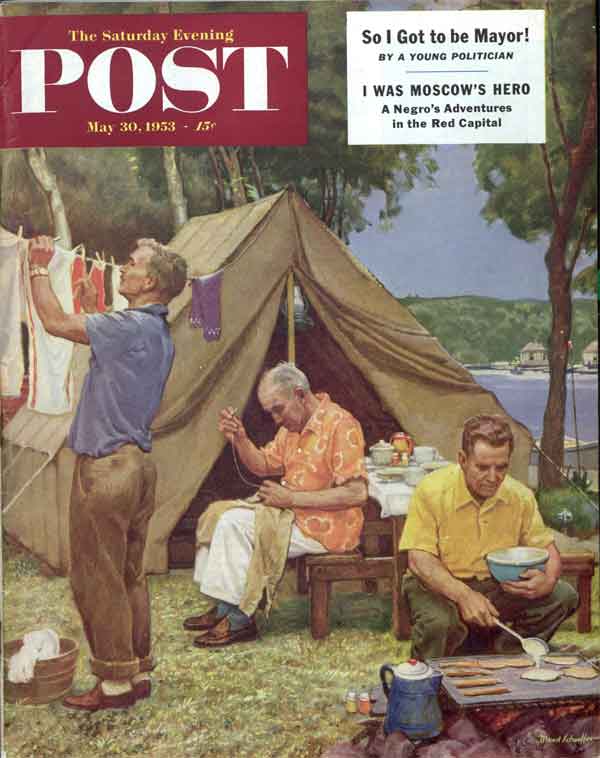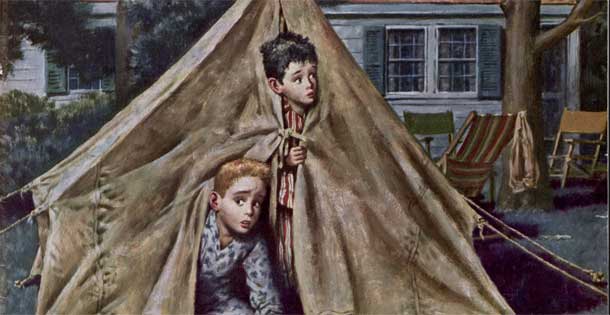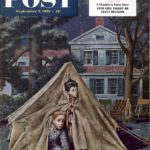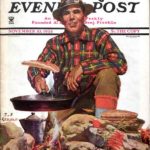
Amos Sewell
September 5, 1953 © SEPS
From cowboys to boy scouts, camping has long been an adventure for all ages. We camp to sightsee in national parks, play in the backyard, cattle drive across the plains, or vacation for fresh air.
For the last hundred years, The Saturday Evening Post has shown many ways in which Americans enjoy the outdoors.
Starting with Amos Sewell’s September 5, 1953 cover, Backyard Campers, two frightened little boys attempt to be tough enough to camp out all by themselves–even if aloneness means the isolation of being the only tent in a fenced-in, suburban yard just steps from the safety of their home.
Still, the little lawn campers are spooked by the foreignness of their own backyard in the darkness. If they get too frightened, they reason, they’ll plan a mad dash to the safety of the house, with warm beds and glowing nightlights for comfort. A rite of passage accomplished, if short-lived.
But camping isn’t just a backyard activity for little boys. As Mead Schaeffer shows, it’s a multi-generational bonding experience. His May 30, 1953 cover, Three Generations Camping, provides a more relaxed setting focused on socialization through outdoor enjoyment. The camping tradition turns boys still afraid of the dark into nature-tested outdoorsmen. In Schaeffer’s illustration, we see a whole family tending to their assigned tasks while a communal breakfast cooks over the griddle.

Mead Schaeffer
May 30, 1953 © SEPS
Speaking of campfire food, mealtime around an open fire is almost as much a right of passage as the act of camping itself. What’s a campout without a bonfire, after all? And what’s a bonfire without campfire food?
Flapjacks by J.F. Kernan, from the November 10, 1934 issue, shows a camper who’s preparing a fresh stack of pancakes over the fire. Meals are the best time for campers to rest from a day of hiking, fishing, trail riding, and general physical exertion. It’s a time to take the boots off, socialize with peers, enjoy the surroundings, and most importantly, replenish lost calories.
These three Post covers idealize the innocent notions of nighttime fears, the happiness of cooking over a fire, and the communal experience of enjoying the outdoors. However, unforeseen circumstance can cause immense frustration that is a far cry from the glossy memories of a good campout. The difficulty of correctly pitching a tent is a familiar, well-worn joke in our culture, as Thornton Utz shows us in Making Camp, from the July 19, 1958 issue. What a maddening mess!
Camping is integral in the American experience, and arguably the least expensive right of passage in this country. Even before smartphones and computers, people felt the need to escape the city and head for the hills, to breathe fresh air, experience wildlife up close, and live a little simply (if uncomfortably) even if just for a weekend. Along the way, The Saturday Evening Post has shared our nation’s appreciation for this truly American experience.
Thornton Utz
July 19, 1958 © SEPS
Mead Schaeffer
May 30, 1953 © SEPS
Amos Sewell
September 5, 1953 © SEPS
J.F. Kernan
November 10, 1934 © SEPS
Become a Saturday Evening Post member and enjoy unlimited access. Subscribe now







